This CE Center article is no longer eligible for receiving credits.
Eastwood Village Primary School
The Eastwood Village Primary School, located in Rotherham, South Yorkshire, United Kingdom, was the first primary school to be built in the town in the past 30 years. The academy instructs students from Foundation Stage 2 through Year 4, a timespan that is comparable to preschool through third grade in American schools, and it offers a nursery. Designed by Rotherham Borough Architects, the £6.4-million primary school was intended to be a modern structure that would support learning in every space. As executive headteacher Mark Young explains, “We will make this school what we want it to be, which is successful, exciting, and vibrant. Everything is brand new. It’s purpose-built, and it’s a perfect space for learning.” The vibrant, purpose-fit intention is even visible in the restrooms, which were thoughtfully designed to best accommodate the little people using them.
The Perfect Partitions for Children
The restroom can be a challenging space for children, especially at school. The goal is to design the space so that it feels safe and secure, without the child feeling trapped. Privacy is important, but locking mechanisms can cause confusion and anxiety. From the unique child-sized cubicles to the fixed knobs, finger guards, and durable phenolic partitions, the restrooms at Eastwood Village Primary School provide an excellent example of the difference that a few special details can make.
Child-Sized Compartments
The ages of the students attending Eastwood Village Primary School range from four to nine years old. Designing spaces to accommodate children within this age range can be tricky because of the vast size and developmental differences that exist between children at either end of the span. On this project, designers decided to create smaller cubicles in the restrooms that would be used by the younger children and provide larger compartments in the restrooms accessed by the older children.
Working with a manufacturer that could deliver different-sized panels in the same type of partition system enabled designers to create restrooms throughout the school that featured consistent colors and materials while tailoring the scale of the space to better fit the students using it. Adjustable pedestal feet enabled installers to make field adjustments if the floors were not level, making installation easy and issue free.
Fixed, No-Lock Door Knobs
Locking stall doors in a restroom used by young children can create several issues. A child may forget how to operate the lock, essentially locking himself or herself inside and causing a distressful situation. A locked door may create a barrier that prevents or delays a caretaker or teacher from being able to access a child inside the compartment who needs help. Luckily, an alternative exists that allows a restroom to be designed for young people without a potentially problematic locking stall door.
Fixed door knobs do not include a locking mechanism. Resembling a simple stem, these devices can be used to open and close the door of a restroom stall, providing privacy for an occupant without creating a barrier to entry or exit. At the Eastwood Village Primary School, these fixed, no-lock door knobs were selected for all the student compartments in the building.
“No-Pinch” Finger Guards
Another feature that helps to protect kids in the restroom space is a finger guard. Designed to shield little fingers from getting pinched between the doors and pilasters, finger guards are supple rubber profiles placed between the two panels that cushion the impact and prevent injury. They also add privacy to a stall without having overlapping, routed edges.
Durable and Vibrant Phenolic Partitions
Restroom partitions are available in a number of different materials, each with their own unique characteristics and benefits. While powder-coated steel, stainless steel, and plastic laminate may be more familiar, phenolic is a material that is gaining momentum in the restroom partition market because it is attractive, durable, easy to clean, and available in a wide range of sizes and colors. Phenolic partitions were selected for use in the Eastwood Village Primary School restrooms.
Phenolic partitions matched the aesthetic and performance needs of the Eastwood space perfectly. There is a distinct orange and grey palette that is featured prominently on the exterior of the building as well as throughout many of the interior spaces. The phenolic partitions are available in so many colors that the designers were even able to pull the vibrant orange and grey color theme into the restrooms.
In terms of performance, phenolic materials are antimicrobial, nonporous, water resistant, and impact and scratch resistant, making them extremely easy to clean and difficult to vandalize. The combination of strength and cleanability was an optimal solution for the primary school environment.

Photos courtesy of ASI Group
At Eastwood Village Primary School, designers decided to create smaller cubicles in the restrooms that would be used by the younger children and provide larger compartments in the restrooms accessed by the older children.
New Headquarters of the Sacramento Regional Builders’ Exchange
The Sacramento Regional Builders’ Exchange (SRBX), a non-profit organization that serves Northern California’s commercial construction industry, recently completed a construction project itself, opening a new and ultra-modern 11,000-square-foot headquarters in Sacramento.
Originally founded in 1901 and currently serving more than 1,100 member companies, the SRBX is the construction industry’s oldest and largest association in the region. Dedicated to supporting the development and advancement of its members by offering educational programs, safety programs, bidding information, political advocacy, and creating networking opportunities to connect people within the industry, the new space is the hub of the organization’s important activities. “The new SRBX facility is a central site for member meetings, industry events, and on-site training,” explains SRBX CEO Tim Murphy. “Creating the right look and feel for this space was essential for conveying the professional nature of our organization.”
A New Level of Privacy and Beauty in the Restroom
It can be difficult to impress members of the building industry with the built environment. Designers selected rich blues, burgundies, and wood tones to complement the polished concrete floors and glass walls found throughout the interior. Murals depicting Sacramento’s history and the skyline that its members helped to build are featured prominently throughout the space. The modern and professional theme was also captured effectively in the restroom with the use of a new partition system that elevated the aesthetic and experience of privacy beyond what was typically found. “These new partitions are stylish and beautiful, extremely durable, easy to clean, and you can’t beat the added privacy,” says Murphy. “They exceed the standard of comfort offered in private facilities.”
A New Level of Privacy
The new restroom compartments installed in the SRBX headquarters offer a private experience, free from the gaping sightlines so often encountered in the restroom stall. The enhanced privacy is the result of two unique features that were designed to eliminate sightlines on either side of the door: the shiplap edge and the continuous, edge-mounted hinge.
The side of the door panel that swings open and shut is outfitted with a shiplap edge so that the material of the door physically overlaps with the adjacent pilaster. The overlap creates a reliable visible barrier along the full vertical edge of the door panel, eliminating the opportunity for a sightline to exist.
On the hinged side of the door, a continuous, edge-mounted hinge eliminates the sightlines that often exist above and below the hinges in a typical compartment. The continuous nature of the edge-mounted hinge means that the hinge runs from the top of the door panel all the way to the bottom, creating a continuous privacy seal as well. When the stall door is opened, the hinge is exposed, but the view into the stall remains completely obstructed. When the panel door is shut, the hinge is hidden, providing a cleaner aesthetic.
Made of HDPE Material
The partition system selected for the SRBX restroom is made from a beautiful mahogany-toned high-density polyethylene (HDPE), which is one of the most commonly used plastics in the United States. Technically speaking, HDPE is a solid plastic material that is manufactured by compounding polymer resins under high pressure to form a solid, single thickness panel, which is why it is often referred to as solid HDPE.
There are many characteristics of this material that make it a good fit for the restroom space. Solid HDPE panels are nonporous and impermeable. They won’t absorb moisture and resist the growth of mold, mildew, and rust. Many other partition solutions are not manufactured from a solid material and instead feature panels with a core that is vulnerable to mold growth. Plastic laminate panels often have a particleboard core, and stainless-steel and baked enamel panels often contain a honeycomb core made of cardboard. Both particleboard and cardboard will host mold, which, over time, can spread throughout the interior of the stall or partition. Beyond mold resistance, HDPE is a highly durable material that resists dents, scratches, corrosion, graffiti, and rust.
Shoeless Pilasters Deliver Cleaner Solution
Because the HDPE material is moisture and mold resistant, HDPE pilasters can be specified without the shoes typically seen on a traditional bathroom partition system. When the panel material is moisture sensitive, as most of them are, the shoes are designed to keep the panels off the ground. Unfortunately, the traditional shoes provide hiding places for germs, bacteria, and mold to grow, and they are difficult to clean. Eliminating the shoe from the partition system results in a much cleaner-looking solution that is, in fact, cleaner and more sanitary too.

Photo courtesy of Scranton Products®
In the headquarters of the Sacramento Regional Builders’ Exchange (SRBX), the restroom partitions are made from solid HDPE and feature shoeless pilasters, which deliver a cleaner aesthetic that is also easier to clean.
Walk into any restroom in the United States, and chances are that there is probably room for improvement. Whether it’s the gaping sightlines that offer glimpses inside an occupied stall; empty dispensers of soap, paper towels, or toilet paper; a hand dryer that does not seem to effectively dry hands; a haphazard layout that sends users zig-zagging from the stall to the sink to the dryer to the door; mistakes in ADA compliance; or any number of assaults on the senses that often occur in this sensitive space, restrooms today can be designed to support the basic needs of their occupants in a much better way.
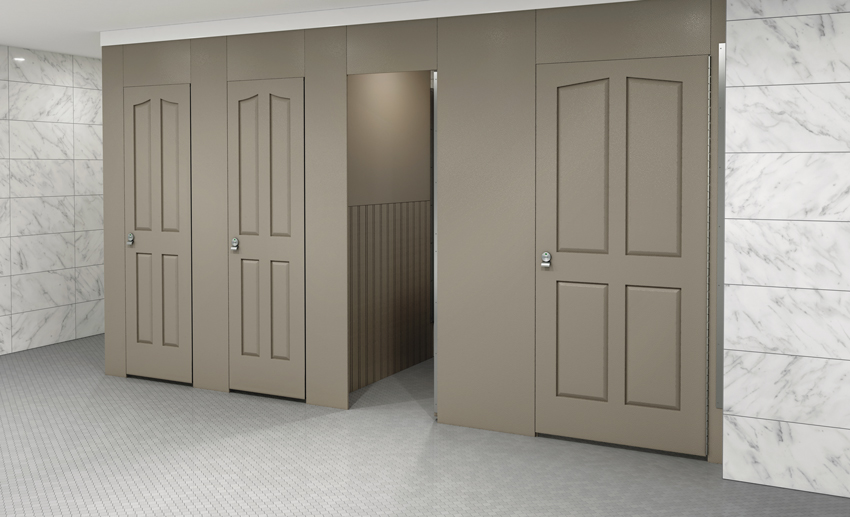
Photo courtesy of Scranton Products®
The surprising truth about the restroom space, from a design perspective, is that while these areas are critical for the day-to-day occupancy and overall functionality of any building, their design is often lower priority than the more readily visible but less crucial areas. In the past, it was common practice to use a master specification for a restroom space, essentially delivering banal, cookie-cutter restrooms to project after project. Unfortunately, the layout, partitions, materials, and accessories contained within the master specification also delivered a lackluster experience that left occupants often complaining publicly about this private space.
Today, there are new product solutions available to address many of the common complaints that users make about restrooms. New types of partitioned compartments and restroom accessories can improve the level of privacy occupants feel in the stall; ensure a sufficient supply of paper towels, soap, and toilet paper is available; streamline the stall-to-sink-to-dryer route; make restrooms easier to maintain and more difficult to vandalize; and feature a distinguishing style that complements the aesthetic themes found in the other interior spaces of the building.
While the specific goals for any restroom project are informed by the building type, the anticipated occupants who will use the facilities, and the statement that designers and owners wish to make in the space, the partitions and restroom accessories selected for the space can be instrumental in achieving them. This course will explore five very different projects—an elementary school, a commercial office space, a hospital, a stadium, and the exquisite Zaha Hadid-designed Port House in Antwerp, Belgium—each showcasing the way these new solutions can be used to create a better modern restroom.
Eastwood Village Primary School
The Eastwood Village Primary School, located in Rotherham, South Yorkshire, United Kingdom, was the first primary school to be built in the town in the past 30 years. The academy instructs students from Foundation Stage 2 through Year 4, a timespan that is comparable to preschool through third grade in American schools, and it offers a nursery. Designed by Rotherham Borough Architects, the £6.4-million primary school was intended to be a modern structure that would support learning in every space. As executive headteacher Mark Young explains, “We will make this school what we want it to be, which is successful, exciting, and vibrant. Everything is brand new. It’s purpose-built, and it’s a perfect space for learning.” The vibrant, purpose-fit intention is even visible in the restrooms, which were thoughtfully designed to best accommodate the little people using them.
The Perfect Partitions for Children
The restroom can be a challenging space for children, especially at school. The goal is to design the space so that it feels safe and secure, without the child feeling trapped. Privacy is important, but locking mechanisms can cause confusion and anxiety. From the unique child-sized cubicles to the fixed knobs, finger guards, and durable phenolic partitions, the restrooms at Eastwood Village Primary School provide an excellent example of the difference that a few special details can make.
Child-Sized Compartments
The ages of the students attending Eastwood Village Primary School range from four to nine years old. Designing spaces to accommodate children within this age range can be tricky because of the vast size and developmental differences that exist between children at either end of the span. On this project, designers decided to create smaller cubicles in the restrooms that would be used by the younger children and provide larger compartments in the restrooms accessed by the older children.
Working with a manufacturer that could deliver different-sized panels in the same type of partition system enabled designers to create restrooms throughout the school that featured consistent colors and materials while tailoring the scale of the space to better fit the students using it. Adjustable pedestal feet enabled installers to make field adjustments if the floors were not level, making installation easy and issue free.
Fixed, No-Lock Door Knobs
Locking stall doors in a restroom used by young children can create several issues. A child may forget how to operate the lock, essentially locking himself or herself inside and causing a distressful situation. A locked door may create a barrier that prevents or delays a caretaker or teacher from being able to access a child inside the compartment who needs help. Luckily, an alternative exists that allows a restroom to be designed for young people without a potentially problematic locking stall door.
Fixed door knobs do not include a locking mechanism. Resembling a simple stem, these devices can be used to open and close the door of a restroom stall, providing privacy for an occupant without creating a barrier to entry or exit. At the Eastwood Village Primary School, these fixed, no-lock door knobs were selected for all the student compartments in the building.
“No-Pinch” Finger Guards
Another feature that helps to protect kids in the restroom space is a finger guard. Designed to shield little fingers from getting pinched between the doors and pilasters, finger guards are supple rubber profiles placed between the two panels that cushion the impact and prevent injury. They also add privacy to a stall without having overlapping, routed edges.
Durable and Vibrant Phenolic Partitions
Restroom partitions are available in a number of different materials, each with their own unique characteristics and benefits. While powder-coated steel, stainless steel, and plastic laminate may be more familiar, phenolic is a material that is gaining momentum in the restroom partition market because it is attractive, durable, easy to clean, and available in a wide range of sizes and colors. Phenolic partitions were selected for use in the Eastwood Village Primary School restrooms.
Phenolic partitions matched the aesthetic and performance needs of the Eastwood space perfectly. There is a distinct orange and grey palette that is featured prominently on the exterior of the building as well as throughout many of the interior spaces. The phenolic partitions are available in so many colors that the designers were even able to pull the vibrant orange and grey color theme into the restrooms.
In terms of performance, phenolic materials are antimicrobial, nonporous, water resistant, and impact and scratch resistant, making them extremely easy to clean and difficult to vandalize. The combination of strength and cleanability was an optimal solution for the primary school environment.

Photos courtesy of ASI Group
At Eastwood Village Primary School, designers decided to create smaller cubicles in the restrooms that would be used by the younger children and provide larger compartments in the restrooms accessed by the older children.
New Headquarters of the Sacramento Regional Builders’ Exchange
The Sacramento Regional Builders’ Exchange (SRBX), a non-profit organization that serves Northern California’s commercial construction industry, recently completed a construction project itself, opening a new and ultra-modern 11,000-square-foot headquarters in Sacramento.
Originally founded in 1901 and currently serving more than 1,100 member companies, the SRBX is the construction industry’s oldest and largest association in the region. Dedicated to supporting the development and advancement of its members by offering educational programs, safety programs, bidding information, political advocacy, and creating networking opportunities to connect people within the industry, the new space is the hub of the organization’s important activities. “The new SRBX facility is a central site for member meetings, industry events, and on-site training,” explains SRBX CEO Tim Murphy. “Creating the right look and feel for this space was essential for conveying the professional nature of our organization.”
A New Level of Privacy and Beauty in the Restroom
It can be difficult to impress members of the building industry with the built environment. Designers selected rich blues, burgundies, and wood tones to complement the polished concrete floors and glass walls found throughout the interior. Murals depicting Sacramento’s history and the skyline that its members helped to build are featured prominently throughout the space. The modern and professional theme was also captured effectively in the restroom with the use of a new partition system that elevated the aesthetic and experience of privacy beyond what was typically found. “These new partitions are stylish and beautiful, extremely durable, easy to clean, and you can’t beat the added privacy,” says Murphy. “They exceed the standard of comfort offered in private facilities.”
A New Level of Privacy
The new restroom compartments installed in the SRBX headquarters offer a private experience, free from the gaping sightlines so often encountered in the restroom stall. The enhanced privacy is the result of two unique features that were designed to eliminate sightlines on either side of the door: the shiplap edge and the continuous, edge-mounted hinge.
The side of the door panel that swings open and shut is outfitted with a shiplap edge so that the material of the door physically overlaps with the adjacent pilaster. The overlap creates a reliable visible barrier along the full vertical edge of the door panel, eliminating the opportunity for a sightline to exist.
On the hinged side of the door, a continuous, edge-mounted hinge eliminates the sightlines that often exist above and below the hinges in a typical compartment. The continuous nature of the edge-mounted hinge means that the hinge runs from the top of the door panel all the way to the bottom, creating a continuous privacy seal as well. When the stall door is opened, the hinge is exposed, but the view into the stall remains completely obstructed. When the panel door is shut, the hinge is hidden, providing a cleaner aesthetic.
Made of HDPE Material
The partition system selected for the SRBX restroom is made from a beautiful mahogany-toned high-density polyethylene (HDPE), which is one of the most commonly used plastics in the United States. Technically speaking, HDPE is a solid plastic material that is manufactured by compounding polymer resins under high pressure to form a solid, single thickness panel, which is why it is often referred to as solid HDPE.
There are many characteristics of this material that make it a good fit for the restroom space. Solid HDPE panels are nonporous and impermeable. They won’t absorb moisture and resist the growth of mold, mildew, and rust. Many other partition solutions are not manufactured from a solid material and instead feature panels with a core that is vulnerable to mold growth. Plastic laminate panels often have a particleboard core, and stainless-steel and baked enamel panels often contain a honeycomb core made of cardboard. Both particleboard and cardboard will host mold, which, over time, can spread throughout the interior of the stall or partition. Beyond mold resistance, HDPE is a highly durable material that resists dents, scratches, corrosion, graffiti, and rust.
Shoeless Pilasters Deliver Cleaner Solution
Because the HDPE material is moisture and mold resistant, HDPE pilasters can be specified without the shoes typically seen on a traditional bathroom partition system. When the panel material is moisture sensitive, as most of them are, the shoes are designed to keep the panels off the ground. Unfortunately, the traditional shoes provide hiding places for germs, bacteria, and mold to grow, and they are difficult to clean. Eliminating the shoe from the partition system results in a much cleaner-looking solution that is, in fact, cleaner and more sanitary too.

Photo courtesy of Scranton Products®
In the headquarters of the Sacramento Regional Builders’ Exchange (SRBX), the restroom partitions are made from solid HDPE and feature shoeless pilasters, which deliver a cleaner aesthetic that is also easier to clean.
The Port House
The Port House in Antwerp, Belgium, designed by Zaha Hadid Architects (ZHA), is a spectacular project that transformed a historic, albeit run-down, fire station into the new headquarters for the world’s fifth-largest port, the Port of Antwerp. In 2007, the offices of the Port of Antwerp had become too small and spread out. Staff was scattered across different buildings throughout the city. There was a need to find more office space and a wish to relocate to a place where technical and administrative services could be housed together. The old fire station on Mexico Island—a listed replica of a Hanseatic residence, ideally situated at the threshold between the city and its vast port—needed a change of use to ensure its preservation so it was selected as the site for the new headquarters.

Photo courtesy of ASI Group
The Port House, designed by Zaha Hadid Architects, contains sophisticated restrooms that complement the crisp lines and bold features of the structure while delivering an extraordinary experience in the space.
An architectural competition ensued with the goal of finding a design that captured the spirit of the city. “There was only one rule laid down in the architectural competition, namely that the original building had to be preserved,” says Marc Van Peel, president of the Port of Antwerp.
The winning design, submitted by ZHA, masterfully combined the 16th century architectural style of the original firehouse with a contemporary expansion clad in shining, rippling glass that seems to float above it, an homage to Antwerp’s moniker as the city of diamonds. Completed in 2016, the building houses activity-based and open-plan office spaces for up to 600 workers with related areas that include: restaurants, meeting rooms, and an auditorium. “The new Port House will be a proud landmark for Antwerp,” says Hilde Crevits, Flemish minister of transport and public works. “The striking design will give Antwerp a wonderful architectural jewel that matches its position and importance as a world port.”
While the design and story of the Port House inspires any number of conversations, this course begs the question, “What do the restrooms look like in a building like that?”
The Sophisticated Restrooms in the Port House
A building that seemingly defies gravity and tantalizes people outside and inside with its extraordinary curb appeal, interiors, and exterior views would not offer a subpar restroom experience. In creating restrooms sophisticated enough to satisfy the design standards of the Port House, ZHA selected elegant, ultra-privacy, extra-height partitions adorned with stainless-steel hardware and coordinating stainless-steel restroom accessories. The crisp lines, bold hardware, and enhanced cubicles offer a beautiful restroom environment that delivers the highest level of privacy and functionality possible today.

Photo courtesy of ASI Group
The restroom compartments in the Port House were designed floor to ceiling to deliver a high-privacy experience, and some of the cubicles are all-inclusive, containing a toilet, sink, and drying station.
Ultra-Private Cubicles
The extra-height cubicles found in the Port House were custom designed to provide users with added privacy in the restroom. While high-privacy compartments typically feature doors up to 72 inches tall and panels up to 75 inches tall, these doors and panels were designed to run from the floor to the ceiling, creating a private enclosure for each patron. The floor-to-ceiling enclosures feature a custom insert that infills the opening that typically exists between the top of the partition and the ceiling when a standard partition product is used. Some of the cubicles were even designed to be all inclusive, containing a toilet, sink, and drying station.
These extra-height partitions are constructed of 13-millimeter-thick high-pressure laminate compact (HPL) material, which is antimicrobial, nonporous, water resistant, and impact and scratch resistant. The black door and panel system includes stainless-steel hardware to create a striking and modern aesthetic that complements the other interior spaces in the Port House.
Zero Sightlines
Beyond private, floor-to-ceiling enclosures, the partition system selected for the Port House prevents any sightline into or out of the stall. The zero-sightline solution features doors and pilasters designed with interlocking routed edges that create a physical overlap at the point of closure. The overlap fully obstructs any view into or out of the compartment, providing the private experience necessary in these most private spaces.
Stainless-Steel Accessories
The restrooms also feature high-quality stainless-steel accessories. The stainless-steel toilet tissue dispensers, hand dryers, paper towel dispensers, and waste receptacles further complement the bathroom decor and the distinct design of the building. Type 304 stainless steel was used to ensure durability and long-lasting elegance.
Lockers at the University Hospital of Missouri
A $190-million patient care tower was recently added to the University Hospital in Columbia, Missouri, that would enhance the outcomes of the thousands of cancer patients treated there annually. With 90 private rooms equipped with smart technology, six operating rooms, a healing garden, a 7,000-square-foot inpatient pharmacy, 10,000 square feet of green roofs, and a 100,000-square-foot cancer center, the eight-story addition seeking LEED Silver certification was specifically developed to blend the latest health-care delivery methods with relaxation and environmentalism.
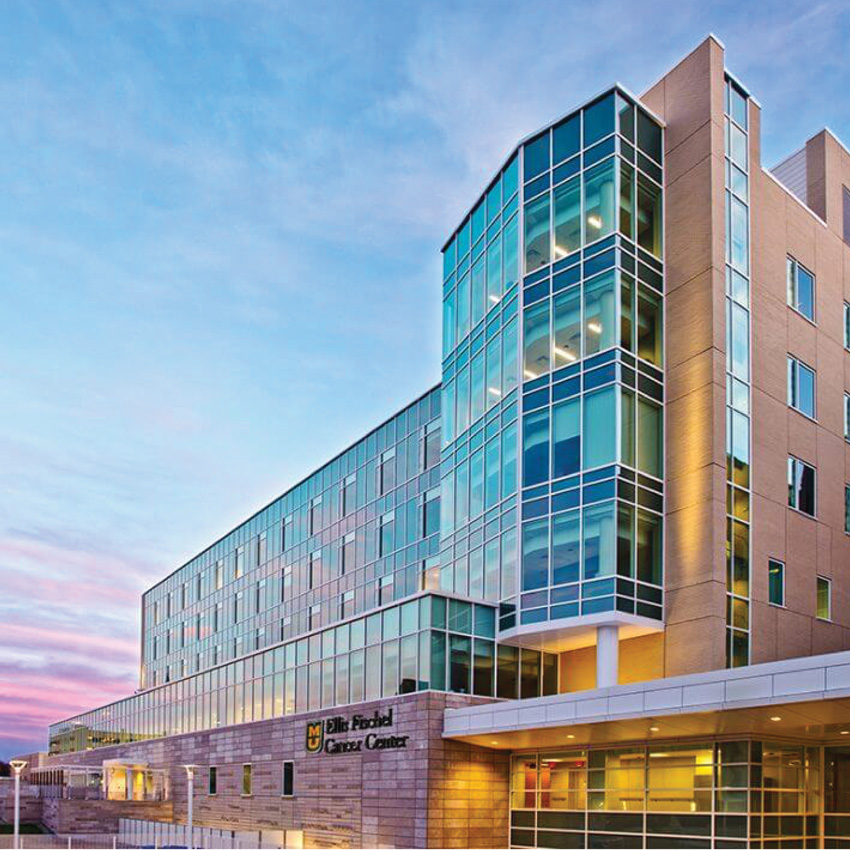
Photo courtesy of Scranton Products®
The new patient care tower at the University Hospital of Missouri features nearly 700 lockers made from solid HDPE for use across the new medical facility and its 10 different locker rooms.
The Sustainable and Sanitary Locker Solution
Designers needed to select nearly 700 lockers for use across the new medical facility, including its 10 different locker rooms. The solid HDPE lockers they chose contributed toward LEED credits for the project and were perfectly suited for the health-care environment in terms of the low volatile organic compound (VOC) emissions levels and resistance to rust, bacteria, germs, and mildew.
LEED v4 Credit Contribution
Solid HDPE lockers can contribute toward several of the LEED v4 credits in the Material and Resources (MR) and Indoor Air Quality (IAQ) categories. The material contains recycled content, is recyclable, is GREENGUARD Gold certified, and is recognized as a low-emitting material.
Contains Recycled Content
The HDPE lockers are made from recycled materials and contain both pre- and post-consumer content. They are available in 100 percent post-consumer material. The recycled content of these lockers can contribute toward earning LEED v4 credits. For example, according to the LEED v4 standard, products meeting recycled content criteria are valued at 100 percent of their cost for the purposes of the credit achievement calculation. This means that HDPE lockers can contribute toward meeting the necessary cost thresholds as required in the Building Product Disclosure and Optimization: Sourcing of Raw Materials credit.
“The recycled content in these lockers made them the ideal choice for the tower’s ecofriendly design and mission to capture LEED certification status,” explains Matt Hackbarth of HOK, the global firm responsible for the design, architecture, engineering, and planning of the University Hospital patient care tower.
100 Percent Recyclable
The lockers made from solid HDPE are also 100 percent recyclable. In fact, HDPE is one of the few materials that can be recycled in its current form. When the lockers are taken down, they can be returned to the manufacturing facility, ground up, and put back into the manufacturing process. HDPE does not lose any of its chemical composition during the recycling process so a locker made with recycled bits will retain the durability, moisture resistance, and antimicrobial properties of the original product.
GREENGUARD Gold Certified
HDPE lockers are GREENGUARD Gold certified, which means they meet strict certification requirements and standards for low emissions of VOCs into the indoor air. The GREENGUARD Gold standard includes health-based criteria that considers chemicals not included in the basic GREENGUARD certification and requires lower total VOC emissions levels. Satisfying these important safety guidelines also indicates that the product is fit for use in health-care facilities, where occupants or patients may be especially sensitive to VOCs.
Low VOC Emissions
The solid HDPE material is formulated from a homogenous color-throughout compound, which means that the lockers will never need to be painted to restore the brilliance of their color. Nor will the color flake or peel or be compromised if the surface is scratched. The solid pieces of HDPE used to construct the lockers retain the color of the product throughout each panel. While there are many time-saving maintenance benefits to selecting nearly 700 lockers that will never need to be painted, there are sustainable benefits as well. The elimination of paint on the product also contributes toward the product being able to satisfy those low VOC emissions standards.
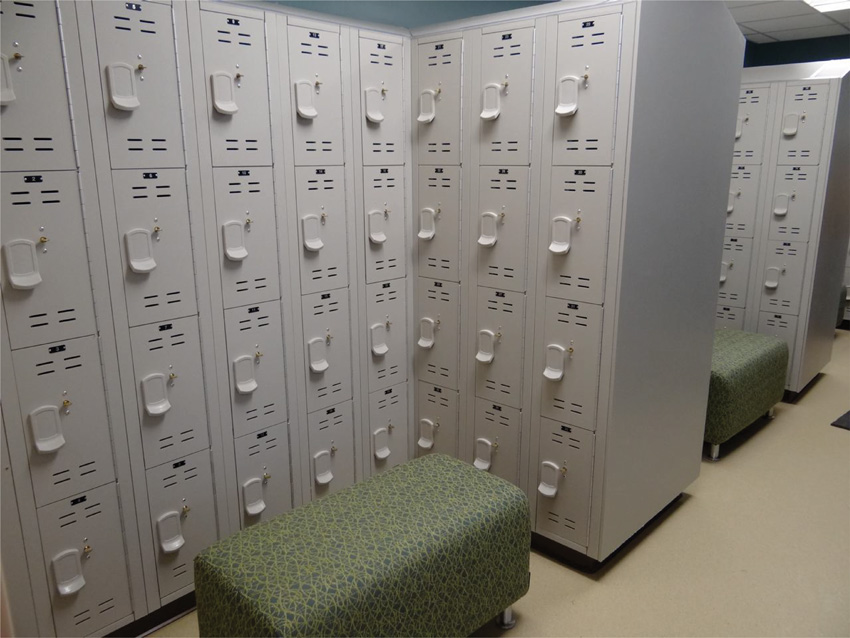
Photo courtesy of Scranton Products®
The solid HDPE lockers selected for this project contributed toward earning several LEED v4 credits because the material contains recycled content, is recyclable, is GREENGUARD Gold certified, and is recognized as a low-emitting material.
Sanitary
HDPE lockers are a natural fit for the health-care space. They are resistant to bacteria, mildew, and mold so nothing will grow inside or outside of the lockers, a characteristic that also helps to protect the integrity of the indoor air quality. Solid HDPE is also naturally germ resistant. Testing conducted by SITU Biosciences, employing the ISO 22196 methods, included a study that explored the ability of MRSA (Methicillin-resistant Staphylococcus aureus) bacteria to live on the HDPE surface. The study found that, after 24 hours, 98.4 percent of the MRSA bacteria had died off the surface of HDPE plastic without the use of any cleaning solutions.
Stadium Bathrooms
Designers of the modern-day stadium are being challenged to push the envelope to create an experience that is so enthralling people will forego the comfort and ultra-high definition (UHD) views from their couch and spend hard-earned cash to watch the game from the cheap seats, snacking on concession stand fare and drinking $12 fountain soda.
The billion-dollar, state-of-the-art stadiums are incorporating all sorts of creature features and functionalities to up the wow factor, such as huge jumbotrons, more comfortable seating, USB ports in every armrest, and more. The Mercedes-Benz Stadium features the world’s largest, five-story-tall, 360-degree HD video halo board and improved Wi-Fi for better in-stadium connections. The 10,000-square-foot Viking Voyage space at U.S. Bank Stadium puts fans of all ages on the virtual field. EverBank Field, home to the Jacksonville Jaguars, offers two wading pools in the north end zone. Fans at Levi’s Stadium can use a mobile app to order food and drinks that will be delivered to their seat.
While the glitz and glam features designed to wow the fans may garner the most press, there are many basic functions that must be performed at a stadium, and even those must now be executed with an elevated level of comfort and convenience. For example, the Mercedes-Benz Stadium now offers a re-engineered gate entry experience, which ensures fans will get into the building in five minutes or less. Restrooms are another area that must be designed to support the basic needs of every fan in a way that rivals, or improves, the experience available at home.
The Private Bathroom Experience in a Public Restroom
Privacy and an ample supply of soap and towels that enable a person to use the restroom, wash and dry their hands quickly, and swiftly return to the action of the game—this experience may describe how a person at home would characterize the benefit of having access to their own personal bathroom facilities while cheering on their favorite team. It is the standard that modern-day stadiums must meet in this space and, with the partitions and restroom accessories now available, it is entirely possible.
No Sightlines
The cornerstone of a private restroom experience is a stall that does not offer clear views into the occupied compartment. This can be provided in a public restroom with the selection of a partition system that is designed to eliminate those irksome sightlines. Different partition materials lend themselves to different privacy-enhancing systems.
Partitions made of phenolic and solid plastic materials can feature door panels that are routed on both sides: the side that locks and the side that hinges. The adjacent pilasters have reverse routing so that the edges of the door panel will overlap with the edges of the pilasters, eliminating sightlines. When the door is closed, the door panel and pilasters will lie in the same plane, adding elegance to the solution. Stainless-steel and powder-coated steel partitions often eliminate sightlines by using a continuous strike keeper on the locking side of the door panel and a hinge-side filler on the hinged side of the door.
Beyond a zero-sightline solution, privacy in the compartment can be enhanced by selecting taller partitions. Doors and side panels can be specified in heights of 72 and 76 inches. These panels can sit lower to the floor and create stalls that are more difficult to see under or over.
Ensure Soap and Paper Towels are Available During Peak Times
Equipping a stadium restroom to handle the soap and paper towel demands of busy peak-time rushes relies entirely upon choosing appropriate restroom accessories. High-capacity paper towel dispensers offer the best solution for meeting the paper towel needs of the masses during these high-demand times. A recent development in soap dispensers now offers the design community a soap-dispensing solution that will keep the soap dispensers at even the most popular sinks reliably dispensing soap to their users.
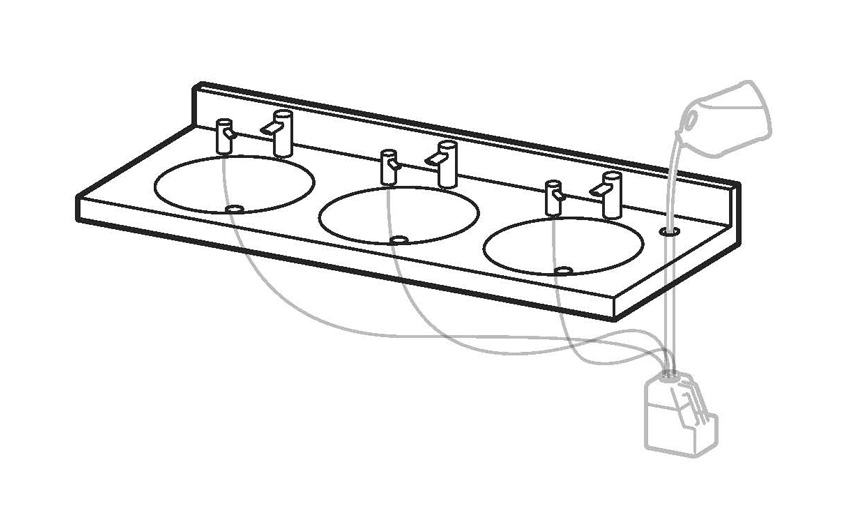
Image courtesy of ASI Group
The multi-feed soap dispenser features a high-capacity central reservoir that holds up to 5 liters of liquid or foam soap, which is automatically supplied to up to six separate soap dispensers.
The multi-feed soap dispenser features a high-capacity central reservoir that holds up to 5 liters of liquid or foam soap, which is automatically supplied to up to six separate soap dispensers. This common well and multi-feed structure enables the more popular soap dispensers access to enough soap to meet the needs of the higher number of users it services. The multi-feed soap dispenser also streamlines the refilling process, saving maintenance personnel precious time and effort by allowing them to pour soap into one larger top-fill reservoir instead of refilling several smaller dispensers that must be accessed from below the sink.
Provide High-Speed and Hygienic Hand Dryers
Advancements in hand dryers also improve the occupant experience in the stadium restroom. Increased drying speeds enable people to dry their hands quicker than ever. In addition to faster drying, some hand dryers now offer more hygienic air. Look for devices with a triple filter that will cleanse the air before using it to dry hands. The triple filter features three layers: a HEPA filter that captures airborne particles, activated charcoal combats odor, and an antimicrobial layer that eliminates 99 percent of bacteria. High-speed dryers can be louder so choosing dryers with lower decibel levels is highly recommended in scenarios where multiple dryers will be activated simultaneously.
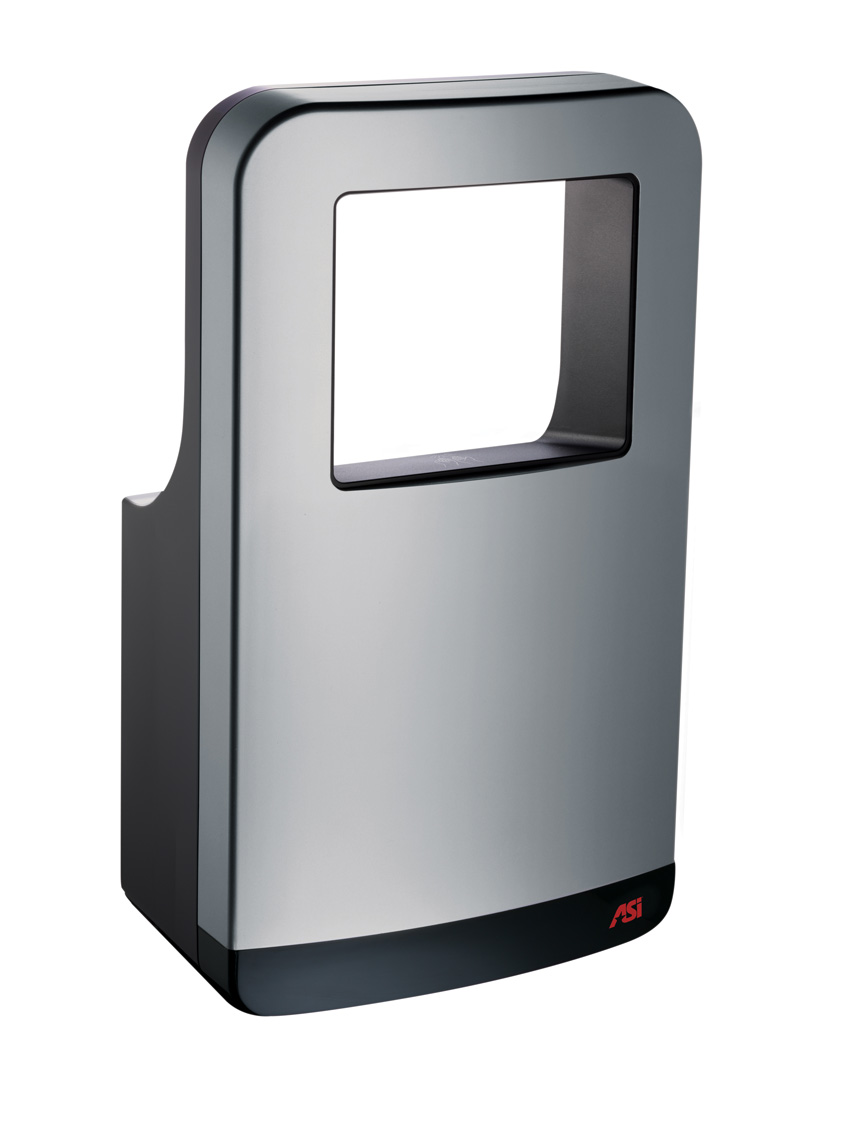
Image courtesy of ASI Group
Some hand dryers now feature a triple filter that will cleanse the air before using it to dry hands.
Digital Tools for Designing the Modern Partition System
The modern partition system now offers an unparalleled number of options that designers may use to create a restroom space that provides a private, comfortable experience in the compartment and complements the aesthetic themes found throughout the more public spaces of the building. With the vast improvements that have been made in the partition solution, recycling a master specification that leaves sightlines looking into and out of the stall and offers a bland, cookie-cutter aesthetic no longer makes sense for any type of project.
However, throwing out the master specification doesn’t mean that designers must spend an extraordinary amount of time creating new specifications for the restroom space. As the various components of a restroom have evolved, so have the tools available to support the design efforts of the team. Now, digital tools enable designers to explore the look and feel of the various partition colors, textures, and panel types available from a tablet or laptop. There are hundreds of combinations that can be viewed and quickly modified. Designers can easily see how the different colors and textures impact the space and compare the look of different panel designs, in different colors as well. Once a preferred partition system has been created, the software then streamlines the specification process by providing the spec language necessary to create the partition system as shown.
New panel heights, colors, trim options, transom panels, door panel designs, side panel designs, pilasters, and special privacy-enhancing features, such as the continuous edge-mounted hinge or shiplap door panel edges that prevent sightlines from existing on either side of the door, are now all part of the modern restroom specification.
New Partition Colors and Textures
Partition systems are now available in an incredible number of colors and textures. While traditional colors such as white, grey, charcoal, and black have been routinely used in this space for years, new collections offer partitions in warm tones, metallic sheens, and bold colors that include burgundy, blueberry, and hunter green options. This expanded palette enables designers to incorporate the broader decor themes found throughout the rest of the building into this private space. The partitions can also feature textures such as rotary brushed, orange peel, hammered, and grip-ex, creating an even more distinct aesthetic in the restroom.
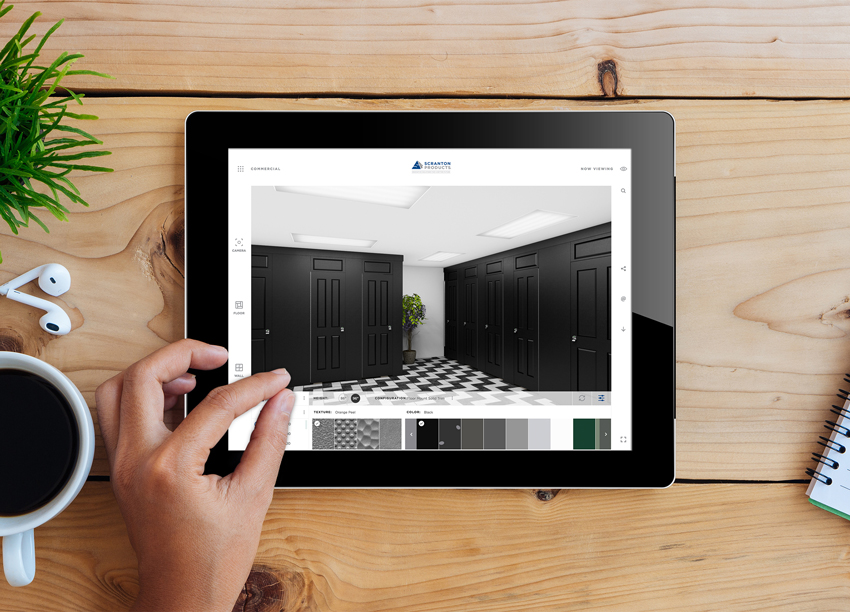
Photo courtesy of Scranton Products®
New software enables designers to quickly view the types of restroom compartments that can be created with new partition colors, panel designs, and trim sizes.
New Door Panel Options
Plain, flat door panels are no longer the de facto door available for the bathroom stall. Now designers can choose from a variety of paneled designs, adding details to the partition system that give the entire space a little more character. These partition doors feature different panel sizes and orientations, creating styles that are recognized as more traditional or more modern, or new, unique patterns that add to the sophistication of the space. Every design heightens the decor available at the restroom door.
New Side-Panel Options
There are also several side-panel design options that can be used to create visual interest inside and outside the toilet compartment. Designers may choose sides that are subtly engraved with two or four panels or inject more personality into the stall with a wainscoting or diamond pattern design.
Trim Options
The trim refers to the top-most border of the partition system, the piece that visually connects the top of the cubicle to the ceiling. The trim piece can be a standard flat panel, feature a beveled edge, or add an additional layer of texture to the partition system with a fluted appearance.
With so many new options available for creating a high-performance, high-privacy partition system with a distinct style, the software that enables designers to quickly view the impact that a color, panel design, or trim size can make on the overall aesthetic of the restroom is a welcome addition to the specification process. The design team can use these digital tools to explore the hundreds of possible combinations and find the solution that best fits the parameters of a project.
In Conclusion
Restrooms can now be designed to better reflect the intention of the building and cater to the unique needs of the users in the space. This renaissance of the restroom space requires the demolition of the master specifications that have been recycled over and over, creating the same restroom across different building types for decades. With the variety of choices that now exist in restroom partitions and the advancements in available restroom accessories, such as high-capacity, multi-feed soap dispensers and ultra-hygienic hand dryers, one thing is certain: restrooms today are no longer the recycled master-spec bathrooms of yesteryear. The restroom has been revived.
Jeanette Fitzgerald Pitts has written dozens of continuing education articles for Architectural Record covering a wide range of products and practices.
























